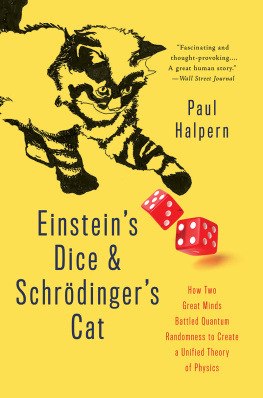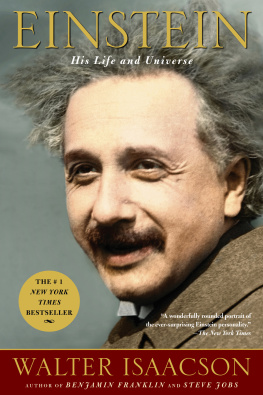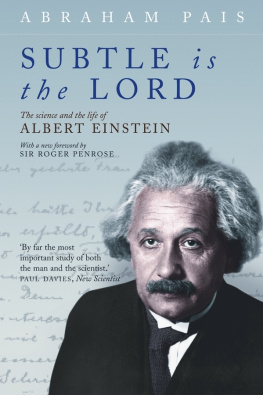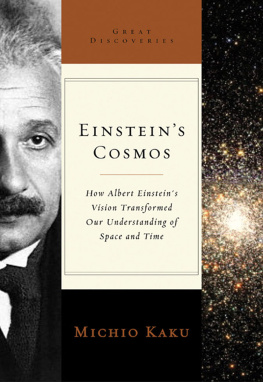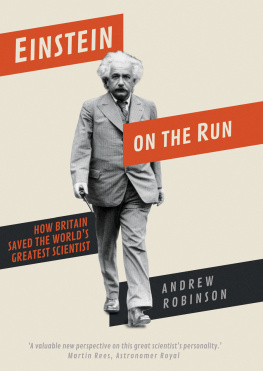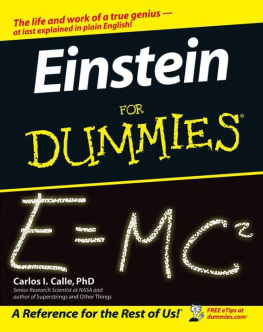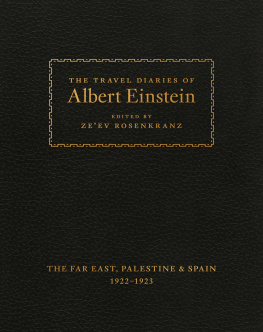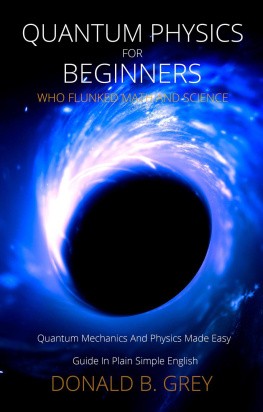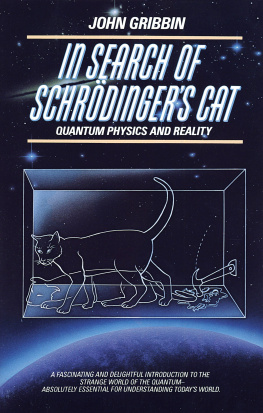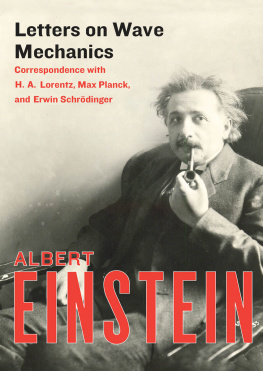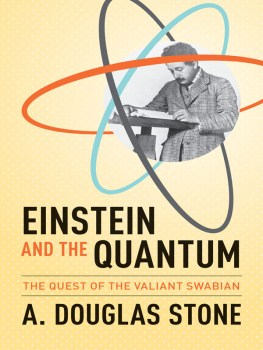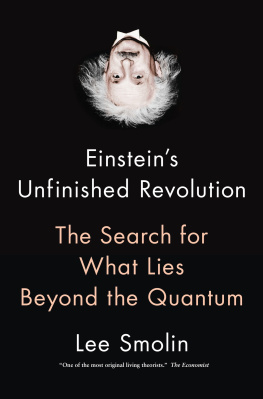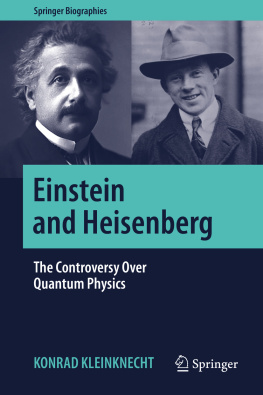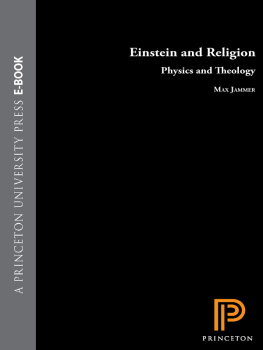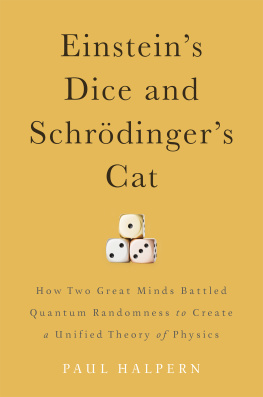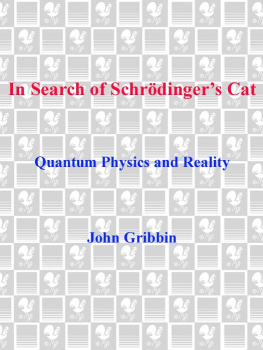PRAISE FOR EINSTEIN'S DICE AND SCHRODINGER'S CAT:
CultureLab Best Read of 2015
This book can be put on the reading list of those who have enjoyed The Theory of Everything and want to know more.
Physics World
A highly approachable book that will appeal to readers...who are interested in physics, the history of science, and the human and political aspects of scientists and their work.
Library Journal
Halperns book has an enormous richness of detail about both mens lives and work.
The Observatory
Thats a lot to cover in a single book, and the author masters this challenge most thoroughly. While the science is covered in detail, the tone and narrative are accessible to readers with all levels of mathematical and physics proficiency. The author has served science writing well by casting light on the relationship between these two pioneers of quantum physics.Indeed, there are lessons about the often-messy process of science in this book for students, scientists, and citizens alike.
MAA Reviews
With verve, Halpern explores the fragile nature of scientific collaboration.... Halpern ably explores the clashing personalities and worldviews that had physics in churning ferment during the early part of the 20th century.
Kirkus Reviews
With his trademark grace and clarity, Paul Halpern shines new light on the personalities, lives, and achievements of two of the twentieth century's greatest theoretical physicists, at the same time illuminating the fascinating interactions between the two. Halpern has a rare talent for bringing both the physics and the human stories to life.
Kenneth W. Ford, former Director of the American Institute of Physics and author of The Quantum World
We have seen books that celebrate Einstein and Schrdinger as two of the greatest scientists of all time. With clarity and diligence, Halpern does something different: he explores how intellectual curiosity and vanity get enmeshed with power struggles and the media to bring out the worst in good-willing people, especially when the stakes are as high as the creation of a God-like theory of everything.
Marcelo Gleiser, author of The Island of Knowledge
Paul Halpern has written a fascinating account of two of the giants of 20th century physics. Both Nobel Prize winners, Albert Einstein and Erwin Schrdinger, friends and at times fractious competitors, struggled to come to terms with the uncertainty and randomness expressed by quantum mechanics. In Einsteins Dice and Schrdingers Cat, the author gives great insight into the philosophies and personal ambition that brought the two brilliant men together and then sadly drove them apart. As a fan of popular science books and someone who has used phrases such as God does not play diceand Schrdinger's Cat in my songs, I found Paul Halperns book illuminating and entertaining.
Roland Orzabal, co-founding member of Tears for Fears
Writing with verve and insight, Paul Halpern tells a striking cautionary tale about friendship, vanity, and the quest to make a great discovery. He gives an exceptionally lucid and engaging account of modern physics, embedded in a rich human tapestry centered on Einstein, Schrdinger, and their friends.
Peter Pesic, author of Music and the Making of Modern Science and Director of the Science Institute at St. John's College in Santa Fe, NM
This is history of science writing at its besteffortless prose, juicy details and a fascinating narrative that casts familiar territory in a whole new light. The friendship and betrayal between Einstein and Schrdinger is a little known story, and Halpern brings it to life with a historians care, a physicists knowledge, and a writers charm. The book provides a poignant look at how philosophy drives scientific progress and is an important critique of how the media shapes and distorts it.
Amanda Gefter, author of Trespassing on Einsteins Lawn
Einsteins Dice and Schrdingers Cat is a fascinating, well-written account of how these two men struggled with one of the most puzzling features of quantum mechanics: the appearance of randomness in nature. Both general and specialist readers will find it of interest.
David C. Cassidy, Professor of Chemistry at Hofstra University and author of Beyond Uncertainty: Heisenberg, Quantum Physics, and the Bomb
Einsteins Dice and Schrdingers Cat
Einsteins Dice and Schrdingers Cat
How Two Great Minds Battled Quantum Randomness to Create a Unified Theory of Physics
Paul Halpern, PhD

New York
Copyright 2015 by Paul Halpern
Published by Basic Books, an imprint of Perseus Books, LLC, a division of Hachette Book Group, Inc.
First paperback edition published in 2016 by Basic Books
All rights reserved. Printed in the United States of America. No part of this book may be reproduced in any manner whatsoever without written permission except in the case of brief quotations embodied in critical articles and reviews. For information, address Basic Books, 250 West 57th Street, New York, NY 10107.
Books published by Basic Books are available at special discounts for bulk purchases in the United States by corporations, institutions, and other organizations. For more information, please contact the Special Markets Department at Perseus Books, 2300 Chestnut Street, Suite 200, Philadelphia, PA 19103, or call (800) 810-4145, ext. 5000, or e-mail .
Designed by Pauline Brown
Library of Congress Cataloging-in-Publication Data
Halpern, Paul, 1961
Einsteins dice and Schrdingers cat : how two great minds battled quantum randomness to create a unified theory of physics / Paul Halpern, PhD.
pages cm
Includes bibliographical references and index.
ISBN 978-0-465-04065-0 (e-book) 1. Quantum chaos. 2. Quantum theoryPhilosophy. 3. PhysicsPhilosophy. 4. Unified field theories. 5. Einstein, Albert, 18791955. 6. Schrdinger, Erwin, 18871961. I. Title.
QC174.17.C45H35 2015
530.13'3dc23
2014041325
10 9 8 7 6 5 4 3 2 1
Dedicated to the memory of Max Dresden, my PhD advisor, whose passion for the history of twentieth-century physics was truly inspiring
Well who am I? (This question is meant in general, the I not referring just to the present writer.) The Image of God, gifted with power of thought to try and understand His world. However naive my attempt at this may be, I do have to value it higher than scrutinizing Nature for the purpose of inventing a device to... say, avoid splashing my spectacles in eating a grapefruit, or other very handy conveniences of life.
Erwin Schrdinger, The New Field Theory
Contents
I would like to acknowledge the outstanding support of my family, friends, and colleagues in helping me see this project to completion. Thanks to the faculty and staff of the University of the Sciences, including Helen Giles-Gee, Heidi Anderson, Suzanne Murphy, Elia Eschenazi, Kevin Murphy, Brian Kirschner, and Jim Cummings, and to my colleagues in the Department of Math, Physics, and Statistics and the Department of Humanities, for supporting my research and writing. I am grateful for the camaraderie of the history of science community, including the APS Forum on the History of Physics, the Philadelphia Area Center for History of Science, and the AIP Center for History of Physics. The warm support of the Philadelphia Science Writers Association, including Greg Lester, Michal Mayer, Faye Flam, Dave Goldberg, Mark Wolverton, Brian Siano, and Neil Gussman, is most appreciated. Thanks to historians of science David C. Cassidy, Diana Buchwald, Tilman Sauer, Daniel Siegel, Catherine Westfall, Robert Crease, and Peter Pesic for useful suggestions and to Don Howard for offering helpful references. I greatly appreciate the help of Schrdingers family, including Leonhard, Arnulf, and Ruth Braunizer, in addressing questions about his life and work. Im grateful to musician Roland Orzabal and philosopher Hilary Putnam for kindly answering questions about their work. Thanks to science writer Michael Gross for his friendly advice on German culture and language. I appreciate the encouragement of David Zitarelli, Robert Jantzen, Linda Dalrymple Henderson, Roger Stuewer, Lisa Tenzin-Dolma, Jen Govey, Cheryl Stringall, Tony Lowe, Michael LaBossiere, Peter D. Smith, Antony Ryan, David Bood, Michael Erlich, Fred Schuepfer, Pam Quick, Carolyn Brodbeck, Marlon Fuentes, Simone Zelitch, Doug Buchholz, Linda Holtzman, Mark Singer, Jeff Shuben, Jude Kuchinsky, Kris Olson, Meg and Woody Carsky-Wilson, Carie Nguyen, Lindsey Poole, Greg Smith, Joseph Maguire, Doug DiCarlo, Patrick Pham, and Vance Lehmkuhl. I offer my sincere appreciation to Ronan and Joe Mehigan for their photographs of Schrdinger locations in Dublin. Thanks to the Princeton University Library Manuscripts Division for permission to peruse the Albert Einstein Duplicate Archives and other research materials and to the American Philosophical Society Library for access to the Archive for the History of Quantum Physics. Many thanks to Barbara Wolff and the Albert Einstein Archives in Jerusalem for reviewing my quotes from Einsteins correspondence to Schrdinger. Thanks to the Royal Irish Academy for information about their proceedings. I thank the John Simon Guggenheim Foundation for a 2002 fellowship, during which I first encountered the Einstein-Schrdinger correspondence.

